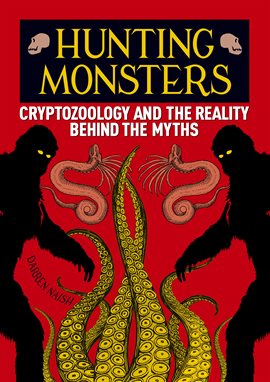For adults, the 2021 summer reading theme of Tails & Tales could hold many meanings. I’ve so far interpreted the theme through the lens of horror and those legends and myths from which our collective nightmares are made. My earlier post on folklore and horror focused on the “tales” portion of this summer’s theme. This time around, I’m bringing you the “tails,” the monsters that we fear when things go bump in the night, the sasquatch that lurks around your campground and the serpent that nips at your feet when you go for a summer swim. Maybe it’s just a snapping turtle or maybe it really is old Nessie? Whatever it is, those fears are very real, and they probably explain why tales of fantastic and frightening beasts will always be with us.
The following books explore this realm of myth, legend and cryptozoology.
“Medusa’s Gaze and Vampire’s Bite: The Science of Monsters” by Matt Kaplan
This delightful and fun read ranges from the mythical beasts of ancient Greece to the sparkly vampires of the Twilight saga. Kaplan speculates in an educated and well researched manner upon the origins of dragons, the Minotaur, werewolves, the Kraken, and even Jaws. Of course, the monsters we humans imagine are evolving along with the things that we most fear, so a healthy portion of the book is a meditation upon human fear. Though Kaplan is a journalist by occupation, he’s a very good storyteller, weaving science, history, and lore into many plausible explanations for the monsters of our horror pantheon.
“Imaginary Animals: The Monstrous, the Wondrous and the Human” by Boria Sax
Boria Sax has created a modern day bestiary that explores the language of animals in Western art and literature. With many fine illustrations pulled from old texts, tapestries, paintings and iconography, Sax gives a historical context with scholarly but understandable exposition on these creatures’ place in culture since ancient and medieval times. He makes the argument that though we often call these animals imaginary or fantastical, their mere existence in the conceptual realm make them as real to humans as any other animal that lives and breathes on Earth. The rich illustrations make this a highly browse-worthy book. You could open it up to any page and start enjoying, but certainly take some time to ponder the greater meaning and symbolism of these fantastic beasts.
“The Essex Serpent” by Sarah Perry
British seasides are perhaps the best possible setting for a Gothic romance, and so is the case with coastal Essex of Victorian Britain. While not strictly a romance, the elements are there: a handsome and recently widowed Cora Seaborne who isn’t as aggrieved as one might expect at her sudden freedom from the constrictions of marriage, a new and exciting change of scenery, the local vicar Will Ransome whom she finds both attractive and repellent (isn’t that always the way?), and looming above it all is the mysterious story of the Essex serpent. The thing that really sets this novel apart from a typical genre romance is the ensuing tug of war between science and faith, with Cora championing science and the vicar claiming that the locals are falling away from their faith and into superstition. This debut novel is thought provoking and truly a joy to read.
This anthology includes 16 stories selected by beloved horror/fantasy/science fiction author Neil Gaiman. Though it is technically a YA book, it has a historical sweep that would be a joy for any lover of the darker corners of short fiction. Consider it a master class in monster storytelling brought to you by one of the masters himself.
“Hunting Monsters: Cryptozoology and the Reality Behind the Myths” by Darren Naish
You want more monsters? We’ve got more monsters! Debates about the existence of mythical creatures and monsters of lore are particularly fun to entertain. These “cryptids” have inspired an entire field of study, known as cryptozoology. Though the term might sound like legitimate science, cryptozoology is widely viewed as a pseudoscience with a cult following. This entertaining book looks at the purported evidence of these mysterious creatures and explores what they might really be (if they exist at all) and the development of cryptozoology itself.



